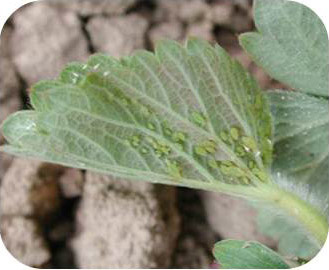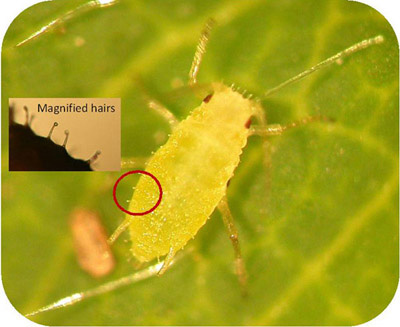Managing strawberry aphids on your farm
Learn about the strawberry aphid, how to identify it from other aphids and products to control it.
Overview
The strawberry aphid (Chaetospihon fragaefolii) is one of several aphid species found in strawberry fields. Sooty mould, which develops on the honeydew secreted by aphids, occasionally damages leaves and fruit. More significantly, aphids can transmit viruses from one strawberry plant to another. The strawberry aphid is the main carrier of several important strawberry virus diseases, including:
- strawberry mottle (SMoV)
- strawberry vein banding (SVBV)
- strawberry mild yellow edge (SMYEV)
- strawberry crinkle virus (SCV)
Identify strawberry aphids
Colour: pale green to yellow
Range size: 0.8 to 1.1 mm (nymphs) , 1.3 to 1.5 mm (adults)
Characteristics:
- small hairs with knobbed ends all over the body
- adults have long antennae (as long as, or longer than their body)
- they prefer to feed on the underside of leaves
Strawberry aphids can be winged or wingless. The winged forms, also known as alates, move from field to field, traveling several km in light breezes.
To find strawberry aphids, examine the underside of new leaves that have not yet uncurled (Figure 1) .
If you see aphids, use a hand lens or microscope to confirm the presence of the knobbed hairs, which is characteristic of the strawberry aphid (Figure 2).
Manage and prevent virus spread
It is important to control strawberry aphids to prevent the spread of viruses from one plant to another and from older infected fields to new healthy plantings. You should control strawberry aphids all season-long. The most critical time for control is in May and June when aphid populations peak and winged adults move from field to field.
There are several products for aphid control. See the Ontario Crop Protection Hub and the product label for complete details.
First treatment
- Make the first application on overwintering strawberries when new leaves are emerging.
- Use a systemic insecticide such as Admire or Cygon/Lagon. Both are very toxic to bees and should not be used when bees are active.
- Do not apply Admire pre-bloom or during bloom. Apply post-bloom only.
Bloom and harvest period
- Follow up as necessary during bloom with foliar applications of Beleaf 50 SG.
- From green fruit to harvest, chose Assail or Beleaf. After renovation use Cygon or Lagon.
New plantings
- You can hold off on aphid control until new leaves are emerging and aphids are present.
- Remove all bloom and blossom clusters on new, June-bearing plantings before application of Admire and apply as a foliar spray.
- Follow up with foliar applications of Beleaf, Assail, or Cygon/Lagon as needed.
Monitor for pests
Monitoring for pests in strawberries is very important. Your aphid control strategy will impact other pests and beneficial insects. Be sure you are scouting because typical pests may not appear and new ones may turn up. For example:
- Applying products for aphids may reduce or delay the need for strawberry clipper weevil and tarnished plant bug control.
- Beleaf is registered for tarnished plant bug suppression and may also help to suppress thrips. Monitor pest activity before spraying additional insecticides.
For more information on products for strawberry aphid control, visit the Crop Protection Hub.

